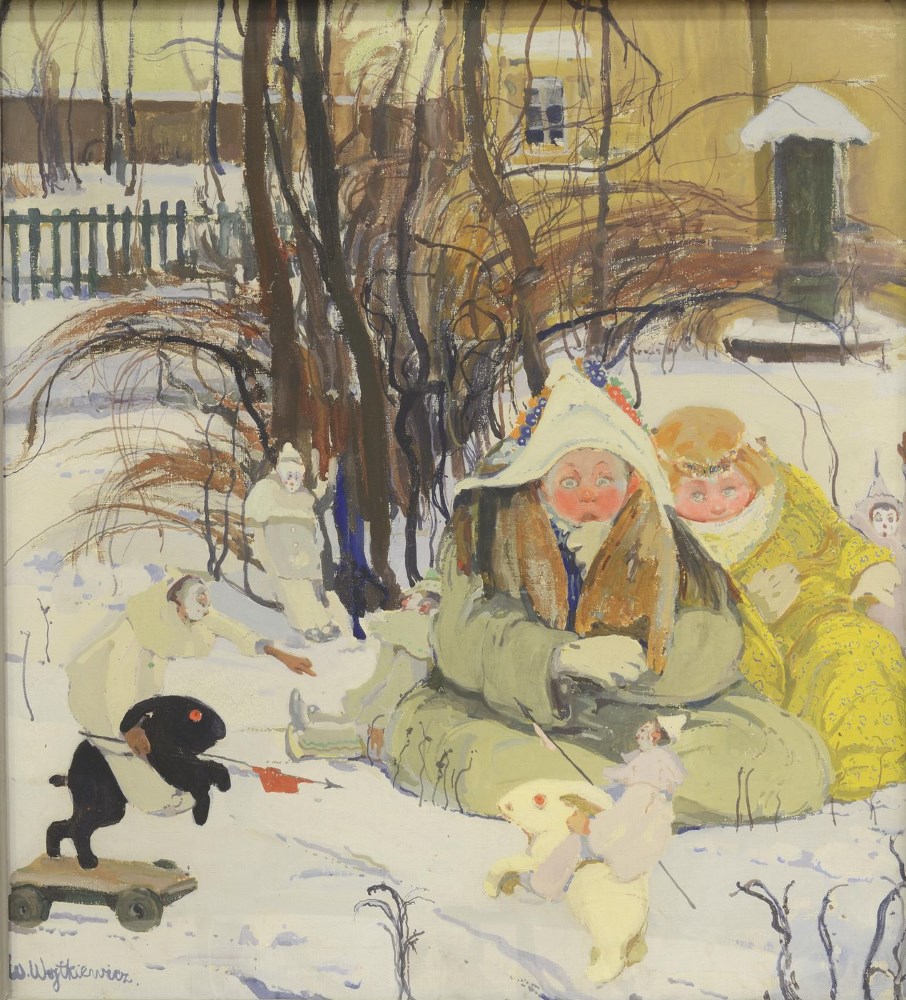Description:
Witold Wojtkiewicz (1879-1909) came from a large middle–class family. In 1903 he began studying at the Krakow Academy of Fine Arts, attending Leon Wyczółkowski‘s studio. He realized himself as a painter, draftsman and graphic artist. He was a co–founder of the “Green Balloon“ cabaret and the “Group of Five“ artistic group, to which Vlastimil Hofman belonged. He has been exhibiting since 1902. He also appeared at the Paris Autumn Salon. In 1908 at the TPSP in Krakow he presented a series of six tempera paintings entitled “From Childhood Poses“ painted a year before the artist‘s death: “Parting“, “Escape“, “Attack“, “Cortege“, “Into the Abyss“, “Tournament“. The works were very quickly purchased. Edward Aleksander Raczyński bought two paintings from this series – the first and the last *.
Description of the painting:
Two children, a boy and a girl, with rosy cheeks, have curled up on the snow. They are warmly dressed, but it seems that for a moment they have forgotten about the cold. They have frozen, full of expectation and fear for the result of the fight that is taking place before their eyes. On the “horse–rabbits“ sit “knights–jesters“ and start a tournament fight with spears.
On the black–coated rabbit, one of the jesters leans over. With a determined move, he extends his arm and points to the opponent, in the direction of which he also aims the spear decorated with a red banner. The “knight“ on the white “horse“ is smaller, gentler and less determinedly responds to the attack. His spear is decorated with a white banner, as a sign of surrendering to the fight. The tournament is not yet decided, however, the black opponent standing on the wheeled wooden board seems to have the advantage.
The boy watching the scene opens his mouth, to which he presses his fist in a silent cry. His terrified look falls on the weaker opponent. The girl looks at the bigger “knight” in concentration, hiding her face in the scarf. Around the children, other scared jesters watch the tournament, and one of them, like a lifeless puppet, leaned against the boy.
The landscape around the children is homely, close and familiar, not surprising, like the surrealism of the foreground. Part of the house with a modest, snow-covered porch and a small window is visible. Next to it stretches an ordinary wooden fence. Behind the children, naked trees and shrubs grow, although quite aggressive in their tangle, they fit into the winter climate.
The children’s heads are crowned, and their warm outfits seem festive, as if a small king and queen were watching the knight tournament together with their subjects around. The girl, with fear, nestles against the boy’s arm, trying to shelter behind him, but he seems to be more scared than her. They watch the tournament of black and white, as if good and evil, and they are afraid, because evil with a bloody banner seems to win, and good capitulates. The thicket of tangled leafless shrubs behind them seems to emphasize their bewilderment, the brutality that surrounds them and which they are forced to look at.
The painting belonged to the group of six tempera paintings constituting the cycle “From Children’s Postures”, which Wojtkiewicz painted in the most productive, but also the last year of his life. They were shown in the winter of 1908 at the headquarters of the Krakow Society of Friends of Fine Arts. The compositions included: I. “Parting” (also in the collections of MNP), II. “Escape” (MNW), III. “Attack” (lost), IV. “Procession” (MNW), V. “Into the Abyss” (lost) and discussed VI. “Tournament (Fight)”. The painting “Parting” and “Tournament (Fight)” was purchased by Edward Aleksander for his collection in Rogalin.
The cycle was partially reconstructed, based on preserved paintings and left reviews. In each painting of the cycle, a children’s pair appeared, experiencing great love dramas, finding themselves in decisive, difficult moments of life. However, as usual, Wojtkiewicz chose children as his heroes, whose attributes are toys. The background and the closest environment of the children in these paintings is their yard, house or garden. The cycle also combines the color scheme in which broken white, moldy greens and browns prevail. With dull colors, sharply contrasting colors, such as yellow on the girl’s dress and blue shadows on the tree trunks in the painting “Tournament (Fight)”.


